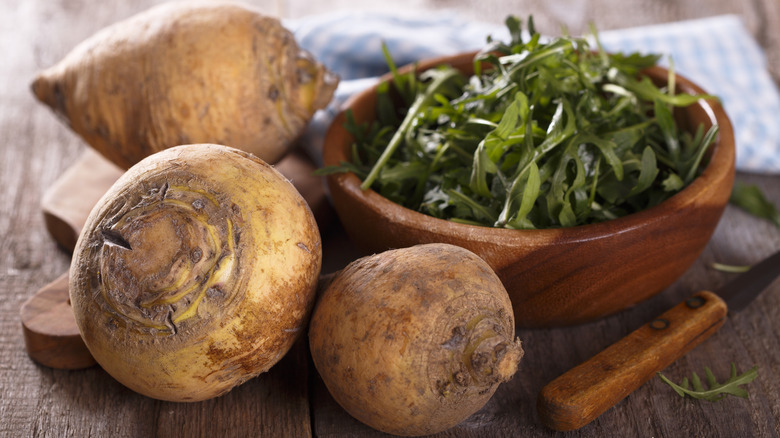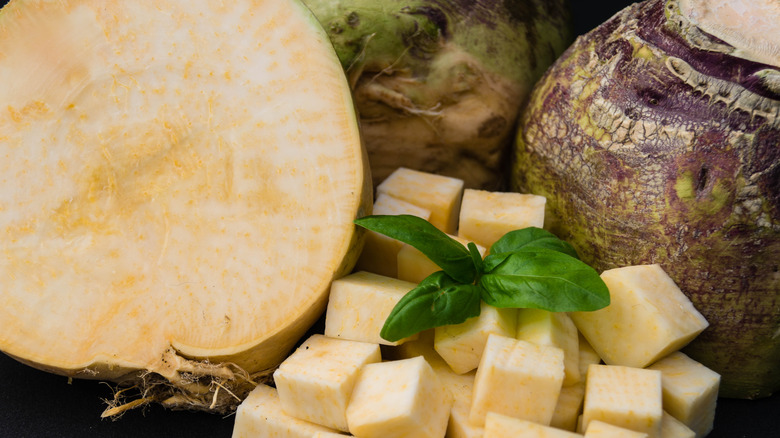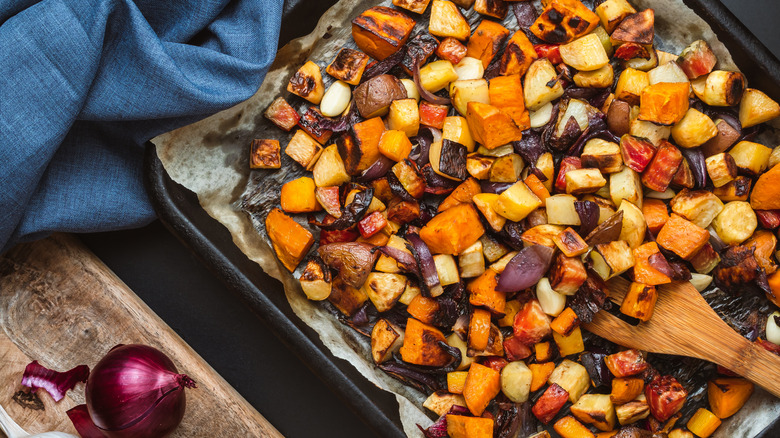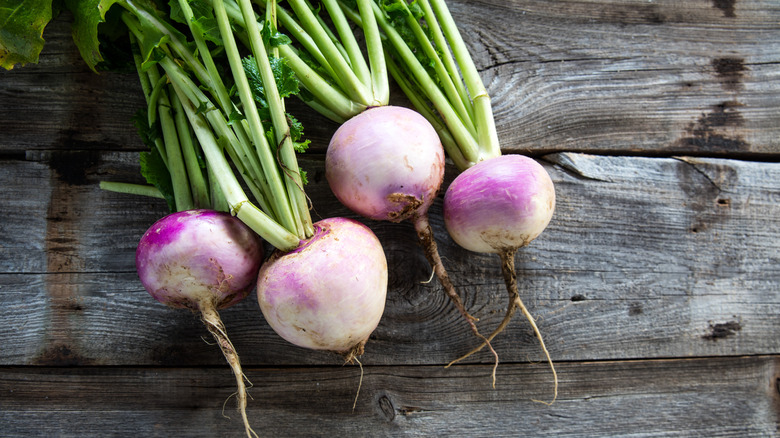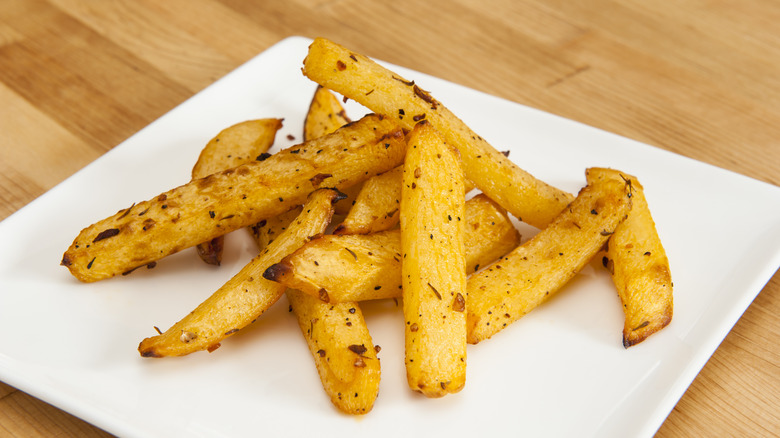What Rutabaga Tastes Like And What You Should Try Cooking It With
The yellow-brownish globes that are sometimes mottled with purple and green may not seem very enticing when you come across them in the produce aisle. You may have always just passed right by them without even bothering to learn their name. Unfortunately, less attractive veggies often get left out in the cold when a shiny, juicy tomato is just a bin away. Or perhaps you've received a rutabaga in a box delivery, had no idea what to do with it, and thought, 'It's like a potato, right?' Well, yes, but the regal little rutabaga is so much more than that.
With the vegetable's culinary rise around World War I and II as a last resort during food shortages (often consumed as a stew with just water, blech) the rutabaga has been sorely overlooked and underestimated. Who wants a last resort as the star of their dish? It's an almost impossible climb from feeding the hungry to fine dining, and the potato may be one of the few veggies that have tackled this edible feat.
The rutabaga is a root vegetable worth exploring and definitely worthy of the spotlight. It has a vegetal, earthy taste, often compared to a milder carrot, cabbage, or turnip (or amalgam of the three). It pairs well with other root vegetables but can also stand on its own. Don't let its size and shape intimidate you. All it takes is a little finagling on the cutting board and you'll have a beautiful vegetable ready for an arsenal of culinary applications.
What is rutabaga and what does it taste like?
Rutabagas are a cross between cabbage and turnips and taste somewhat like that. They are a member of the Brassica family, which includes both cabbage and turnips plus broccoli, cauliflower, Brussels sprouts, and mustard greens — to name a few of the famous family member favorites. Rutabagas are sometimes referred to as Swedish turnips or swedes, as Sweden is where they were first found growing in the wild. Rutabaga is a hearty root vegetable that prefers cooler temperatures and peaks as a fall and winter crop. They store well for months in the fridge.
The rutabaga's taste is milder but with sweet tones and sometimes just a tinge of bitterness. Much like their fellow Brassica family members, they have a somewhat sharp and pungent, almost peppery bite to them. (This is due to the presence of sulfur in the vegetable family.)
Their flesh is a golden yellow akin to a stick of salted butter and they taste nearly as creamy and rich when cooked. Raw, they are delightfully crisp and juicy with a subtle starchiness that lingers on the palate, a bit reminiscent of jicama. Enjoyed both cooked and raw, there is a myriad of ways to prepare the resourceful rutabaga.
What to cook with rutabaga
The beauty of cooking with rutabaga is that it can wear many different vegetable hats — from mashed, hashed, and frenched like the potato to shaved raw like the jicama to roasted amongst the other root vegetables and can hold its form in a stew. It can even be made into a cake like a carrot and spiralized into a plate of pasta, offering a much heartier veggie noodle alternative than zoodles.
When cooked, the rutabaga takes on a creamy texture, making it perfect for a rustic mash with some cream and butter, a more silky purée after a round or two in the food processor, or blasted in a high-speed blender for a velvety soup. It can also take on the role of potato in a cheesy gratin.
The applications of cooking rutabaga also extend to how you would use most of its cousins in the Brassica family. Think of it as a stand-in for broccoli in a broccoli cheddar soup, caramelized at a high heat in the oven like Brussels sprouts, or air fried like the cauliflower.
Rutabaga can take on the role of root vegetables and Brassicas, making it a pretty versatile vegetable.
Rutabaga vs turnip
While rutabaga may be part turnip with a similar shape and appearance, some noticeable differences exist. For starters, it is much larger. The average turnip is only a couple of inches in diameter whereas rutabaga can grow up to a foot wide. (Though it is best enjoyed around three to five inches in diameter.) Turnips are typically white with some purple, while rutabagas are often yellow and brown, sometimes with a bit of purplish brown or green.
Flavor-wise, rutabagas have a sweeter taste than turnips and their butter-colored flesh is strikingly different from the turnip's stark white. Turnips are also crunchy but taste similar to cabbage when raw. Turnips have a little more zesty spice comparable to a radish than the milder rutabaga. However, regarding the flavor and texture profile in terms of use in a recipe, the two are pretty much interchangeable. Just keep the subtle differences in mind when envisioning the outcome of your dish.
From a nutrition standpoint, rutabagas are higher in carbs (hence the sweetness) and have almost double the amount of fiber than turnips, per Leslie Beck RD. On that note, what other health benefits does the rutabaga offer?
Nutrition of rutabaga
Rutabagas are an excellent source of vitamins and minerals, including vitamins E and C, magnesium, calcium, and potassium, according to Healthline. A medium-sized rutabaga (which might be easy to consume in a french fry form), has over 100% of your Daily Value of vitamin C. They also provide some folate, phosphorus, and selenium. They also contain antioxidants, which can help reverse oxidative damage and protect your body from free radicals.
They also provide a good source of dietary fiber, particularly insoluble fiber which adds bulk to stool, helps keep you feeling full, and is good for your gut health. Of note, as WebMD points out, there can be too much of a good thing if you suffer from digestive issues. Cruciferous vegetables like rutabaga may upset the digestive system of those with IBS or other belly woes.
They're pretty low in calories, coming in at just 143 in that medium-sized rutabaga. Compared to a potato, the carbohydrates and calories in rutabaga are slashed in half and the fiber content is quadrupled. Probably the better choice for a french fry, no?
